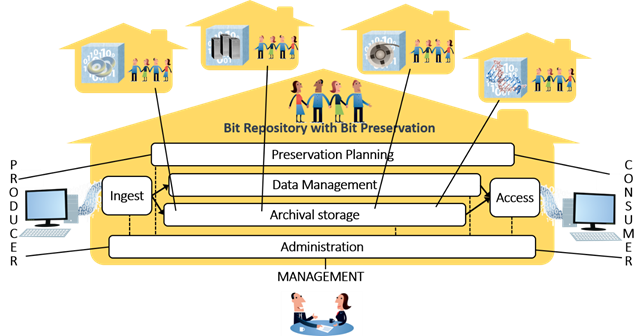Eld Zierau is Digital Preservation Specialist PhD at the Royal Danish Library in Copenhagen, Denmark
And yes, it does involve technology, but technology is just a tool, in the same way as a word processing editor is a tool for a writer.
Today, there is a growing awareness of the need for bit preservation, but there are still a lot of talk about backup, hardware longevity, bit preservation as a technology solution etc. I will here focus on the technology contra non-technology parts, and I will therefore take the liberty to assume the following: It is common knowledge, that there needs to be copies of data in bit preservation, and that these copies of data are equally worthy (not backup copies of an original), and that the copies of data (replicas) are regularly checked and fixed for errors.

Figure text: Bit preservation with coordinated independent replica units in different organisations, expressed in OAIS terms and images from digitalbevaring.dk
This all sounds like technology, - but there are also a growing awareness that there should be at least geographical independence between replicas. This is where the non-technological issues sneaks in: the independency aspect of bit preservation. And it is far from just a question of having geographical independence. As David Rosenthal has pointed out many times most errors are related to human errors, which means that bits are in risk, if the technology supporting the bit preservation is operated or developed by the same people. This points at organisational independence. Then comes risk associated with media, where there is an existing example of loss of seven out of ten replicas due to a hardware error emerging in hardware for the seven replicas. There is also the operating systems, the type of media, etc. It is all about independence, where some of independence subjects are related to technology, but it is not a technology question as such.
Now, there is also other questions, like costs, legal framework, confidentiality issues, preservation policies etc. Given a tight budget, a prioritisation must be made according to costs of implementation of independence. Legal frameworks may limit where and how replicas can be placed. Preservation policies concerning formats and compression can furthermore challenge the costs. Bit preservation of confidential materials is even more complicated, since it is related to extra security costs, legal framework may be more strict, and more copies to ensure bit safety means greater risk of leaking confidential materials. This is why bit preservation is just as much a question of risk analysis as it is about technology. It will only be the organisation with the responsibility of bit preservation, that can make such a risk analysis, - and then choose the right bit preservation solution involving number of copies and their independence.
When accepting that bit preservation is about risk analysis, the next step is to accept that risk management is needed in order to evaluate the risks and take appropriate action when risk probability and impact is too big. The only way to make risk evaluation is to audit the bit preservation solution on a regularly basis, and to make changes if needed. And it is not just audits of the replica units, it is just as important to audit the coordination and independence parts.
Although, it may seem very basic to advocate for risk management and audits, there are still a lot of cases where audits are not performed or even possible. The experience in Denmark is that we cannot rely on audit certifications. There needs to be specific audits that ensure that the contracts are followed, but also to sharpen contracts in cases where we have discovered risks that were not covered before (for example, time lap from data arriving to an offline tape replica unit until it is finally written and securely locked away). The experience is also that many organisations are reluctant to allow audits to be performed in their organisation.
Finally, there is the question of taken action in order to keep probability of risks low. One action could be to move one replica from one unit to another. Such an action has both costs and risks involved, and there may be cases where contractual or political issue can make it almost impossible. Therefore, this ought to be kept in mind when settling for a bit preservation solution.
Hopefully, this give some insight to why bit preservation is not (just) a question of technology.
